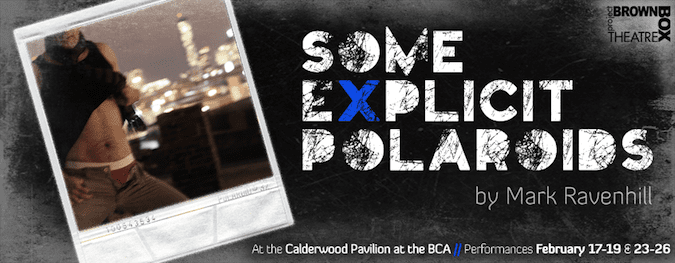 A new company has journeyed to Boston to make its new home with a daring production of the provocative play Some Explicit Polaroids written by British playwright Mark Ravenhill. The Brown Box Theatre Project features local Boston actors with a mix of Boston and New York City designers and, with this show, makes a stark departure from their previous tour of Twelfth Night in Maryland and Delaware.
A new company has journeyed to Boston to make its new home with a daring production of the provocative play Some Explicit Polaroids written by British playwright Mark Ravenhill. The Brown Box Theatre Project features local Boston actors with a mix of Boston and New York City designers and, with this show, makes a stark departure from their previous tour of Twelfth Night in Maryland and Delaware.
The crew creates a dynamic environment in the set and lights; I was surprised to walk into the Calderwood Pavilion at the Boston Center for the Arts’ black box theatre to literally see junk onstage. Cory Rodriguez has an impressive set of credentials, and he’s truly outdone himself in the scaffolding and structure of the set. Unfortunately, most of the set is more a stage picture than a fully functional environment for the characters. There are large portions of the stage that never see stage traffic during the ninety-minute performance. In fact, by the end, I felt that tightening in the set to create a more intimate playing space for the actors could’ve strengthened the production.
Some Explicit Polaroids is an acting exercise and relies very little on technical theatre technique. Unfortunately, not all of the actors rose to this exercise challenge. The star of the show, thankfully, is Scarlett Redmond who plays Nadia, a troubled young woman with a dark past and difficulties connecting with the people around her. Redmond is commanding and assertive on stage in the depth of her character and conviction. She is magnetic; from the way she smiles to her dismissal of her convict lover, she commits to every moment with gusto. I kept wishing for another scene with Redmond and any other character. I also found myself measuring the other actors based on their relationship with Redmond. Joe Ruscio does an admirable job as Nick, the ex-convict trying to regain control over his world. His best scenes sparkle with Redmond, while his scenes fall flat with Chelsea Schmidt who plays Helen, especially later in the show. Schmidt and Ruscio lack any believable chemistry and their attempts at intimacy looks forced. Thankfully, Ruscio and Redmond zing with chemistry as their relationship goes on an emotional rollercoaster in the short duration of the play.
Redmond’s best scenes, however, are with Nick Chris who plays Victor, a European boy-toy. I was quite impressed with Chris’s verve in this daring role. While the style of the whole show comes from the British “In Yer Face” movement, Chris’s role really exemplifies this the most and he attempts the difficult part with passion and strong choices. Passion aside, the role of Victor doesn’t highlight the actor’s strengths as much as it could; though Chris maintained his accent well, it got in the way of his performance at times. Redmond and Chris sparkle as friends without any romantic chemistry, a task that I truly enjoy seeing accomplished onstage. Unfortunately, Chris and Terry Torres (who plays Tim, Victor’s “daddy” who is sick with AIDS) don’t have the same luck in their relationship. A large portion of the story rides on the intimacy between these two characters, but I never felt like Torres fully committed to his role. I found myself annoyed with Tim as a one-dimensional character, then I was annoyed with myself for disliking the dying character who has AIDS. I kept hoping for a moment that would help me change that opinion… it never came.
My biggest complaint with the production is not the lack of technical acting chops, far from it. Director Kyler Taustin has assembled an impressive cast of technical actors to tackle this demanding play. Unfortunately, despite Taustin’s strong directing and choices, the cast never generates the appropriate level of chemistry and relationships to form a believable work. Fortunately, Redmond’s story is enough to create a dynamic and engaging performance by itself. What could have been any character’s play was truly only Redmond’s story. I am okay with that. And I suggest you enjoy it. Her story alone will inspire you with questions and concerns for the Generation X, Y or whatever Generation this production or the audience chooses to associate with. And that is all I can ask from a good night of theater.
